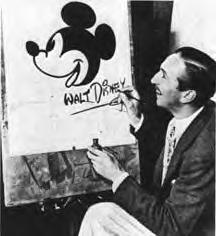
Walt's Career 
On his returned from France, he wanted to pursue a career in commercial art, which soon lead to his experiments in animation. He began producing short animated films for local businesses, By the time Walt had started to create The Alice Comedies, which was about a real girl and her adventures in an animated world, Walt ran out of money, and his company Laugh-O-Grams went bankrupted. Instead of giving up, Walt packed his suitcase and with his unfinished print of The Alice Comedies in hand, headed
for Hollywood to start a new business. He was not yet 22. The early flop of The Alice Comedies inoculated Walt against fear of failure; he had risked it all 3 or 4 times in his life. Walt's brother, Roy O. Disney, was already in California, with an immense amount of sympathy and encouragement, and $250. Pooling their resources, they borrowed an additional $500, and set up shop in their uncle's garage. Soon, they received an order from New York for the first Alice in
Cartoon land (The Alice Comedies) featurette, and the brothers expanded their production operation to the rear of a Hollywood real estate office. It was Walt's enthusiasm and faith in himself, and others, which took him straight to the top of Hollywood society.
Although, Walt wasn't the typical Hollywood mogul. Instead of socializing with the "who's who" of the Hollywood entertainment industry, he would stay home and have dinner with his family In fact, socializing was a bit boring to Walt Disney. Usually he would dominate a conversation, and hold listeners spellbound as he described his latest dreams or ventures
On July 13, 1925, Walt married one of his first employees, Lillian Bounds, in Lewiston, Idaho. Three years after Walt and Lilly wed, Walt created a new animated character, Mickey Mouse. His talents were first used in a silent cartoon entitled Plane Crazy. However, before the cartoon could be released, sound was introduced upon the motion picture industry. Thus, Mickey Mouse made his screen debut in Steamboat Willie, the world's first synchronized sound cartoon, which premiered at the Colony Theater in New York on November 18, 1928.
Walt's drive to perfect the art of animation was endless. Technicolor was introduced to animation during the production of his Silly Symphonies Cartoon Features. On December 21, 1937, Snow White and the Seven Dwarfs, the first full-length animated musical feature. The film produced at the unheard cost of $1,499,000 during the depths of the Depression, the film is still considered one of the great feats and imperishable monuments of the motion picture industry. During the next 5 years, Walt Disney Studios completed other full-length animated classics such as Pinocchio, Fantasia,
Dumbo, and Bambi. Walt rarely showed emotion. At home, he was affectionate and understanding. He gave love by being interested, involved, and always there for his family and friends.
Probably the most painful time of Walt's private life was the accidental death of his mother in 1938. After the great success of Snow White and the Seven Dwarfs, Walt and Roy bought their parents, Elias and Flora Disney, a home close to the studios. Less than a month later Flora died of asphyxiation caused by a faulty furnace in the new home. The terrible guilt of this haunted Walt for the rest of his life.
In 1940, construction was completed on the Burbank Studio, and Disney's staff swelled to more than 1,000 artists, animators, story men, and technicians.
The remainder of his efforts was devoted to the production of comedy short subjects, deemed highly essential to civilian and military morale. Disney's 1945 feature, the musical The Three Caballeros, combined live action with the cartoon animation, a process he used successfully in such other features as Song of the South and the highly acclaimed Mary Poppins. In all, his studio produced more than 100 features. Walt Disney's dream of a clean, and organized amusement park, came true, as Disneyland Park opened in 1955. As a fabulous $17-million magic kingdom, soon had increased its investment tenfold, and by the beginning of its second quarter-century, had entertained more than 200 million people from all over the globe. His death occurred December 15, 1966.